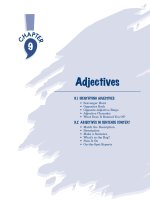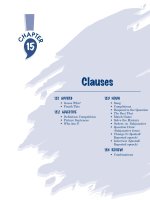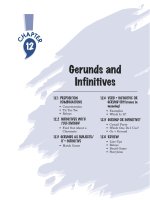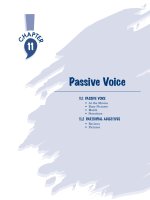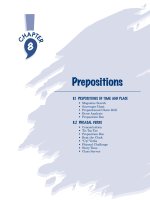fun With Grammar - Prepositions
Bạn đang xem bản rút gọn của tài liệu. Xem và tải ngay bản đầy đủ của tài liệu tại đây (309.25 KB, 18 trang )
8
Prepositions
8.1 PREPOSITIONS OF TIME AND PLACE
•
•
•
•
•
Magazine Search
Scavenger Hunt
Prepositional Chain Drill
Error Analysis
Preposition Bee
8.2 PHRASAL VERBS
•
•
•
•
•
•
•
•
Concentration
Tic Tac Toe
Preposition Bee
Beat the Clock
“Up” Verbs
Phrasal Challenge
Story Time
Class Survey
8.1
PREPOSITIONS OF TIME AND PLACE
1. MAGAZINE SEARCH
Materials:
Dynamic:
Time:
Procedure:
Magazines to share in groups
Small groups
15 minutes
1.
On the board, write a list of prepositions of place that the students
have studied. Divide the students into groups of three or four and
give each group several magazines. You may want to ask students
to bring in their own. If you are supplying them, be sure that they
have full-page ads or other large pictures.
2.
Give the groups a time limit and have them search through their
magazines to find a picture that contains situations illustrating
prepositions of place.
3.
When the time is up, each group goes to the front of the class,
holds up its picture, and explains (in sentences) the contents of the
picture, using prepositions of place.
Example:
4.
The dog is under the table.
The table is next to the man.
The table is in front of the window.
The group that found a picture allowing them to correctly use the
most prepositions of place from the list on the board wins.
NOTE: With an intermediate group, choose a wider range of
prepositions that they have already reviewed.
2. SCAVENGER HUNT
Materials:
Dynamic:
Time:
Procedure:
Worksheet 50, objects filled in
Various objects provided by instructor
Pairs
20 minutes
Before students come into the classroom, distribute various objects
around the room, placing them in visible positions that students
can describe using their prepositions of place. List the objects on
the worksheet.
2.
160
1.
Divide the class into pairs and give each pair a copy of the
worksheet.
3.
The students look around the room for each object listed on the
worksheet and write a complete sentence describing its location.
The first group to finish brings their worksheet to you to be
checked. If the answers are correct, that group wins.
3. PREPOSITIONAL CHAIN DRILL
Materials:
None
Dynamic:
Whole class
Time:
10 minutes
Procedure:
1.
Review prepositions of place.
2.
Take a small object, such as a pen, and do something with it, then
describe your action. (Put the pen on the desk and say, “I put the
pen on the desk.”)
3.
Give the pen to a student and ask him/her, “What did I do with the
pen?”
4.
The student answers and then does something different with the
object that involves a different preposition of place.
5.
The student then passes the object to the next student and asks,
“What did we do with the pen?” That student repeats what the
teacher did and what the first student did with the object. The
second student then does something different with the object
before passing it to the third student.
Example:
Teacher:
Alfredo:
Damian:
6.
I put the pen on the desk. What did I do with
the pen?
You put the pen on the desk.
(to the next student, Damian) I put the pen
above my head. What did we do with the pen?
The teacher put the pen on the desk. Alfredo
put the pen above his head. I put the pen
under my book.
(to the next student) What did we do with the
pen? etc.
This activity continues until no one can do something different
with the pen that can be described using a preposition of place.
NOTE: You may want to write the prepositions that have been used
on the board to help the students remember.
Variation:
Give each student a card to use with a preposition of place on it.
161
4. ERROR ANALYSIS
Materials:
Dynamic:
Time:
Procedure:
Worksheet 51 or other similar picture
Pairs
20 minutes
1.
Divide the class into pairs. Give each pair a copy of the worksheet
or other similar picture.
NOTE: If you are using your own picture, also give the pairs several
sentences you have written about the picture, as on the worksheet.
Some sentences should be accurate, and others incorrect.
2.
The pairs read the sentences about the picture and decide if they
are correct or incorrect in their preposition usage. If they are
incorrect, they must correct them.
3.
When a pair is finished, check their work. If this is a competition,
the first pair to finish the worksheet correctly wins. If using this
activity as a review activity, go over the answers together when
everyone has finished.
SUGGESTION: As a follow-up activity, have each pair write 10
True/False sentences with which to challenge another pair.
5. PREPOSITION BEE
Materials:
Dynamic:
Time:
Procedure:
Worksheet 52A or 52B for instructor’s use
Teams
10 minutes
1.
Divide the class into two teams. Have them line up along opposite
walls, or arrange their desks in two lines.
2.
The first student from Team A steps to the front of the class. Read
a sentence, omitting the preposition. The student must fill in the
blank. Several answers will probably be possible; give the team a
point for any appropriate answer.
3.
Alternate students from the two teams until everyone has had a
turn or you are out of time. The team with the most points wins.
SUGGESTION: Instead of reading the sentences, use an overhead and
reveal one sentence at a time. This avoids repetition and helps the
students to focus on the sentence.
NOTE: You may want to make your own sentences based on the
prepositions your class has covered. This activity could also be done
at a higher level with sentences using phrasal verbs.
162
8.2
PHRASAL VERBS
1. CONCENTRATION
Materials:
Dynamic:
Time:
Procedure:
Board, instructor’s grid
Groups
25 minutes
1.
Draw a grid on the board with just the numbers. On a paper, your
grid will have the answers written in.
NOTE: In the example below, the phrasal verbs have been taken
from the list in Fundamentals of English Grammar. Several of the
verbs in the chart below can take more than one particle, but the
list is usually limited to one or two combinations. It is important to
choose combinations you have studied and to limit entries so that
three or even four matches are not possible. If you have studied
more than one combination (such as ask out, ask over, and ask
around) and you want to review them using this activity, you will
need to use some particles more than once. That way, the students
will be able to make matches such as ask out, drop out, and so on.
This chart is intended only as a model to help you explain the
game; your own chart will be geared to the lessons in your class.
On the board:
1
6
11
16
2
7
12
17
3
8
13
18
4
9
14
19
5
10
15
20
3 drop
8 off
13 write
18 put
4 up
9 down
14 start
19 fool
5 through
10 fill
15 throw
20 call
Instructor’s grid:
1 ask
6 around
11 in
16 over
2.
2 back
7 out
12 get
17 away
Divide the class into groups of about five. Tell them that this is a
memory game and no writing is allowed. Explain that they are
looking for matches and will get a point for each match. They can
confer as a team, but you will accept an answer only from the
student whose turn it is. They can call out two numbers together the
first time since no one knows where any of the words are. In
subsequent turns, they should wait for you to write the first answer
before they call out their second number.
163
3.
As the first student calls out numbers, write the words that
correspond to these numbers in the blanks. Ask the class if it is a
match. If not, erase the words. If so, leave them there and cross
them out (see below).
On the board:
1
6 around
11
16
Variation:
2
7
12
17
3
8
13
18
4 up
9
14
19 fool
5
10
15
20 call
Instead of matching the verb with an appropriate preposition, you can
set up the grid to review meaning. Your instructor’s grid might then
look like this model. Follow the same rules for the game above.
Instructor’s grid:
1 call back
2 give back 3 stop
sleeping
6 return
7 invent
4 stop a
5 get
machine/
through
light
with
8 return
a call
9 start a
machine/ 10 throw
out
light
13 be
careful
14 put off
15 discard
16 wake up 17 postpone 18 turn on
19 watch
out for
20 finish
11 make up 12 shut off
2. TIC TAC TOE
Materials:
Dynamic:
Time:
Procedure:
Board, Worksheet 53 (optional)
Teams
10 minutes
Draw a tic tac toe grid on the board with the first word of the
phrasal verbs written in. Divide the class into two groups.
2.
A student from Team X comes to the board and writes in the
corresponding particle for the verb he/she selects. If correct, he/she
draws his/her mark in the square (an X). (You may choose to
accept only combinations you have studied in class or that are
listed in the students’ books, or you may decide to accept any
correct combination. Whichever you decide to accept, make your
decision clear to the students before playing the game.)
3.
164
1.
A student from Team O then comes to the board and does the
same. If an answer is incorrect, the student cannot draw his/her
mark and erases the answer. The next player on the other team
may choose that same square or another square.
4.
The first team with three marks in a row wins.
NOTE: You will probably want to explain game strategy such as
blocking, but often the student’s choice is based on which verb
he/she knows.
5.
As a follow-up, divide the class into groups of three and use the
worksheet. One student is X, one is O, and the other is in charge
and can have his/her book open to the verb page to judge whether
an answer is correct. After the first game, the students should
rotate roles so that the judge is now one of the players. Continue
until all students have had a chance to be the judge. As you will
see, some of the verbs on the handout take several different
prepositions. As long as the students make an acceptable phrasal
verb, the answer is correct.
NOTE: The items on the worksheet come from the list in
Fundamentals of English Grammar. If this worksheet is not
appropriate to your class, modify it.
Variation:
On the grid on the board (or on a modified worksheet), fill in the
squares with both parts of phrasal verbs. When a student selects a
certain square, he/she must use the phrasal verb in a complete
sentence which demonstrates understanding of the meaning. If the
sentence is correct, the student puts his/her team’s mark in that
square.
Example:
ask out
get off
turn off
do over
give up
make up
fill up
try on
hang up
A student from Team X chooses “give up.” The student then makes a
sentence orally: I couldn’t understand the assignment, so I gave up.
The sentence must reflect the student’s understanding of the meaning
of the phrasal verb. A sentence such as I gave up or Don’t give up is
not acceptable. If a sentence is accepted as being correct, the student
writes an X over the square. A student from Team O then chooses a
square and makes a meaningful sentence using that phrasal verb.
Alternate turns until one team has three in a row or the game is a
draw.
3. PREPOSITION BEE
See the directions for the Preposition Bee on page 162. Use
Worksheet 54 or a similar list of your own sentences.
165
4. BEAT THE CLOCK
Materials:
Dynamic:
Time:
Procedure:
3” x 5” cards (see sample)
Teams
30 minutes
1.
Put a sentence using a phrasal verb on one side of as many index
cards as you need. Review and discuss phrasal verbs. Have the
students create sentences or dialogues and practice orally.
2.
Divide the class into two teams, A and B. Arrange the teams so
that Team A’s desks are directly across from (and touching) Team
B’s desks. If using tables, have Team A sit on one side and Team B
on the other side.
3.
Show the students the front of a card. The first student (A or B)
who answers with a phrasal verb that correctly replaces the verb
on the card gets a point for his/her team. If that student can then
use the phrasal verb in a sentence with the correct tense, his/her
team gets an extra point.
Example:
Card:
Student response:
I raised my children in Ohio.
bring up
I brought my children up in Ohio.
Sample cards:
FRONT
BACK
I raised my children in Ohio.
I met John by chance at the
mall.
run into
Tell Jill to return my call.
call back
Please be sure to arrive for
the test at exactly 8:00.
166
bring up
show up
5. “UP” VERBS
Materials:
Dynamic:
Time:
Procedure:
3” x 5” cards
Pairs/Small groups
20 minutes
1.
Write one verb on each card. Choose some verbs that can also be
phrasal verbs with up.
Examples:
ask
check
cross
get
(can’t be used with up)
(can be used with up)
(can’t be used with up)
(can be used with up)
2.
3.
Tell the students to divide the cards into two piles: verbs with
up/verbs without up.
4.
Variation:
Divide the class into pairs or groups of three or four. Give each
group a stack of verb cards.
When all the up verbs are found, have the students take turns
explaining the meaning of each phrasal verb to the other students
in the group.
Make three identical sets of vocabulary cards. Divide the class into
three teams. Tell the students to find the up verbs. The team that
finds the most up verbs wins. Each correct up verb is worth one point.
For each incorrect up verb, subtract one point from the total score. Use
the same procedure for any phrasal verb pattern (for example, out,
away, through, etc.).
6. PHRASAL CHALLENGE
Materials:
None
Dynamic:
Pairs
Time:
Procedure:
30 minutes
1.
Divide the class into pairs. Tell the pairs to write down eight
phrasal verbs and their meanings that they think the rest of the
class will not know.
2.
After they are finished, join two pairs and have the first pair
challenge the other pair. Each pair takes turns reading the phrasal
verbs from their list and having their opponents state the meaning
of each phrasal verb and use it in a sentence.
3.
If the opponents answer correctly, they get a point. The pair with
the most points wins.
167
4.
For homework, have the students use the phrasal verbs that they
missed in correct sentences.
7. STORY TIME
Materials:
Dynamic:
Time:
Procedure:
3” x 5” cards, writing paper
Small groups
40 minutes
Divide the class into groups of three, and give each group five
3” x 5” cards.
2.
Each group writes down a different phrasal verb on each of their
index cards. You may want to let them use the lists in their books.
Have them write the definition of each phrasal verb on the back.
3.
Have the groups quiz each other as to meaning by showing only
the front of the card to another group.
4.
Next, each group makes a sentence orally for each phrasal verb.
Rotate the cards again until each group has seen every card and
can make a logical sentence. Monitor the groups during this phase.
5.
When the students have a good grasp of the definitions, return
their original phrasal verb cards to them. Each group now writes a
paragraph using all of their phrasal verbs.
6.
When the students have finished, rotate their papers clockwise
and the 3” x 5” cards counterclockwise. (Each group will have
another group’s story and a new set of cards.)
7.
Each group reads the paragraph and adds a second paragraph,
using their new group of phrasal-verb cards.
8.
Have them repeat steps 6 and 7. Each group should now have a
three-paragraph story.
9.
168
1.
Return the original story to each group. Tell the students to look it
over and make any changes they think are necessary. Have one
student from each group read the story to the class. Collect the
stories for a final teacher correction.
8. CLASS SURVEY
Materials:
Dynamic:
Time:
Procedure:
3” x 5” cards in four different colors
list of difficult phrasal verbs
sheets of newsprint and markers (optional)
Groups
40 minutes
1.
Choose four themes and for each theme make up a set of questions,
using the phrasal verbs that you want to practice. (You may want
to have the students compile a list.)
Examples:
Family:
Do you take after your father or your mother?
Did you grow up in a large family or a small family?
Do you get along well with your brothers and sisters?
Are you named after anyone in your family?
School:
Do you go over your notes after class?
Do you try to get out of doing your homework?
Do you ever have trouble keeping up with the assignments?
What is an important grammar point that you have to look
out for?
2.
Write one set of questions on one yellow card, one set of questions
on one green card, etc.
3.
Divide the class into groups. (Four groups of four works well, but
five groups of five or three groups of three also works. Put extra
students into existing groups to work as pairs.)
4.
Tell the students that they are going to do some investigation into
the society of the classroom by doing a survey. Give each group a
set of same-color cards and a theme: The Yellow Group—Family;
The Green Group—Friends, etc. Give the question card to the
group leader and a blank card to each of the other members.
5.
The group members copy the questions from the group leader’s
card on their own cards so that each has a card with the same
questions. They may add questions of their own if they wish or if
there is extra time. Any additional questions must include a
phrasal verb.
6.
When each member has an identical set of questions, the teams
stand up and form new groups with one member of each color. (If
there are extras of one or two colors, they can work as partners
within the group.)
169
7.
In their new groups, the students take turns interviewing each
group member. The yellows ask their questions first and record the
data, then greens, then blues, etc. Everyone asks everyone else in
the group his/her questions.
8.
The students reform their original same-color groups, summarize
their findings, and present them to the entire class. If time
permits, have the groups prepare a visual on newsprint in the
form of a pie chart, a graph, a list of statistics, or another type of
visual. The posters can be part of the presentation and later be put
up around the board.
NOTE: To save time, write out the duplicate cards yourself on
colored index cards or copy one set of questions on different-colored
paper. This will take the place of step 5. Collect the cards and reuse
them in later classes.
SUGGESTION: This activity works well with preposition combinations
instead of phrasal verbs.
Examples:
Best Friends:
What do you look for in a best friend?
Is your best friend patient with you?
Do you ever hide anything from your best friend?
Do you ever argue with your best friend?
Work:
Are you content with your job?
Do you look forward to going to work?
Do you forget about your job when you leave at the end of the
day?
Does your boss ever take advantage of you by having you do
extra work?
170
Worksheet 50: SCAVENGER HUNT
With a partner, find the objects on the list. They are all located somewhere in
the classroom. Then write a complete sentence that includes a prepositional
phrase to describe each object’s location.
Objects:
1.
6.
2.
7.
3.
8.
4.
9.
5.
10.
Locations:
© 1997 Prentice Hall Regents. Duplication for classroom use is permitted.
1.
2.
3.
4.
5.
6.
7.
8.
9.
10.
Fun with Grammar
171
Worksheet 51:
ERROR ANALYSIS
With your partner, decide whether the sentences desribing the picture are
correct or incorrect. If they are incorrect, correct them.
__ 6. The cat is under the table.
__ 7. The baby is beside the father.
__ 8. The hot dogs are next to the
plates.
__ 9. The chairs are under the table.
__10. The grill is in front of the man.
© 1997 Prentice Hall Regents. Duplication for classroom use is permitted.
__ 1. The bird is on the umbrella.
__ 2. The sandwiches are behind the
salad.
__ 3. The spatula is on the man’s
hand.
__ 4. The hammock is between a tree
and a pole.
__ 5. The dog is under the table.
172
Fun with Grammar
Worksheet 52A: PREPOSITION BEE (LOWER LEVEL)
1. What time do you get up
the morning?
2. She is sitting
me.
3. The roof is
our classroom.
4. I have a doctor’s appointment
5. Scott was born
10:30.
June.
6. Do you have any money
your wallet?
7. I am standing
Sarah and Alison.
8. I’ll meet you
the library this afternoon.
9. Our classroom is
the office.
10. Before the test begins, please put your books
11. Keiko attends class
9:00
© 1997 Prentice Hall Regents. Duplication for classroom use is permitted.
12. What time does it get dark
13. I’ll be
the table.
2:30.
night?
my office after class if you want to talk to me.
14. Please keep your notes
your notebook.
15. I’m always cold because there is a ceiling fan directly
desk.
16. When it’s cold, I wear a sweater
17. Hugo works out in the gym
my shirt.
Saturday.
18. Where’s my pencil? I don’t see it, but it must be
somewhere.
19. The back seat is
20. I’m going
my
here
the driver’s seat in a car.
to take my dog for a walk.
21. The children pressed their noses
inside the store.
the glass to see what was
Fun with Grammar
173
Worksheet 52B: PREPOSITION BEE (HIGHER LEVEL)
1. I’ll meet you
4:00, give or take 15 minutes.
2. Mary was walking
from her car when I saw her.
3. It’s raining; you’d better put a coat
4. Marco was walking
your dress.
the river when he fell in.
5. He set the vase
the table.
6. The basketball went
the hoop.
7. The sign warned people not to lean
the newly painted wall.
8. My partner’s eyes kept closing
was so embarrassing!
9. Shut the computer
if you are the last to leave.
Mexico, but he has lived here for 10 years.
11. You can’t get Jasmine’s attention when she is
her friends.
12. There were many accidents
13. The glass fell
a group of
the big storm last week.
her hands
the floor.
14. Because of my allergies, the doctor told me I would have to go
chocolate.
15. My house is located
the city limits.
16. Your final essays are due
17. Jordan was born
May 27.
the last day of July.
18. I sat in the middle seat,
Luci and Claudia.
19. Because of all the trees, I can’t see what is
buildings.
20. Dogs must be
their yards or on a leash.
21. Is there any holiday that is celebrated
174
Fun with Grammar
those
the world?
© 1997 Prentice Hall Regents. Duplication for classroom use is permitted.
10. Max is
the entire presentation. It
Worksheet 53: TIC TAC TOE
hand
look
put
try
wake
make
shut
run
do
figure
grow
find
fill
tear
ask
© 1997 Prentice Hall Regents. Duplication for classroom use is permitted.
pay
call
drop
write
watch
pick
look
keep
hang
hang
give
fill
Fun with Grammar
175
Worksheet 54: PREPOSITION BEE (PHRASAL VERBS)
1. I first asked my girlfriend
on a date two years ago.
2. I had a message to call you
.
3. Rumi gave
figure
on her math homework because she couldn’t
the problems.
4. My handwriting was so messy that my teacher told me to do my
homework
.
5. Ali is very easy-going; he gets
everyone.
6. If the classroom gets too hot, take
sweaters.
! There’s a big pothole in the road.
8. The copy machine ran
make you copies.
paper, so I couldn’t
9. I need an alarm clock to wake
10. They are tearing
.
the old building on the corner.
11. I’ll lend you the money if you promise to pay me
12. Before our teacher hands
put our books
.
our tests, she always tells us to
.
13. Yuji is not a serious student; he is always fooling
in class.
14. I know this class is difficult, but try to get
it.
15. Hitoshi grew
in a small town in Japan.
16. Cassio hung
homework.
the phone before I could ask him about the
17. I like to buy clothes, but I hate trying them
.
18. If you don’t know how to spell a word, look it
dictionary.
19. Elena lost her essay and had to start
in the
.
20. I ran
my former teacher in the parking lot today. I hadn’t
seen him in three years.
176
Fun with Grammar
© 1997 Prentice Hall Regents. Duplication for classroom use is permitted.
7. Watch
your sweatshirts and



